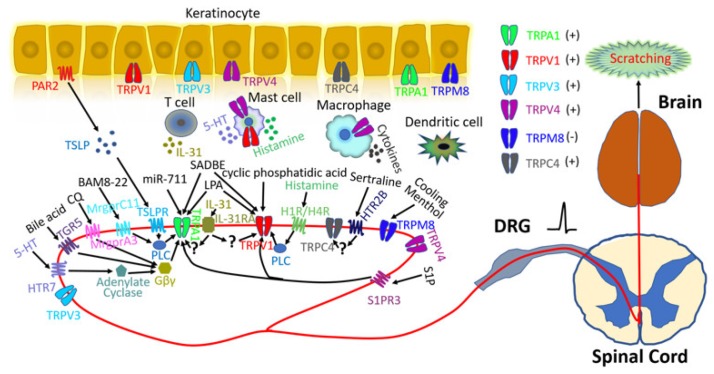Figure 1.
Transient receptor potential (TRP) channels and itch signaling. Six TRP channels are implicated in itch signaling, including TRPA1, TRPV1, TRPV3, TRPV4, TRPM8, and TRPC4. All itch-related TRP channels are expressed in keratinocytes and/or primary sensory neurons. TRPA1 is required for itch evoked by chloroquine (CQ), bovine adrenal medulla 8–22 peptide (BAM8-22), 5-hydroxytryptamine (5-HT), bile acid, and thymic stromal lymphopoietin (TSLP) which can be released from keratinocytes through protease-activated receptor 2 (PAR2) activation. These pruritogens bind to their respective G protein-coupled receptors (GPCRs): Mas-related G protein-coupled receptor member A3 (MrgprA3), MrgprC11, 5-hydroxytryptamine receptor 7(HTR7), G protein-coupled bile acid receptor Gpbar1 (TGR5), and thymic stromal lymphopoietin receptor (TSLPR). Phospholipase C (PLC) and Gβγ signaling downstream from these receptors contribute to TRPA1 activation. TRPA1 also mediates miR-711-induced itch through direct activation. TRPV1 is required for histamine-evoked itch, whereby histamine receptor 1 (H1R) and histamine receptor 4 (H4R) activate TRPV1 through the PLC signaling pathway. TRPV1 also participates in cyclic phosphatidic acid-induced itch through direct activation. Both TRPA1 and TRPV1 are involved in squaric acid dibutylester (SADBE)- and lysophosphatidic acid (LPA)-induced itch through direct activation. In addition, both TRPA1 and TRPV1 are required for interleukin-31 (IL-31)- and sphingosine 1-phosphate (S1P)-related itch, but the detailed mechanisms remain unresolved. Mutations of amino acid residues in TRPV3 have been associated with Olmsted syndrome (OS), suggesting a potential role in itch signaling. Emerging data implicate TRPV4 in both histaminergic and non-histaminergic itch, but results from different research groups are controversial [27,28,29]. HTR2B and TRPC4 are involved in selective serotonin reuptake inhibitor (SSRI)-evoked pruritus. Unlike other TRP channels, TRPM8 activation inhibits itch and is required for cooling- and menthol-mediated itch inhibition.

